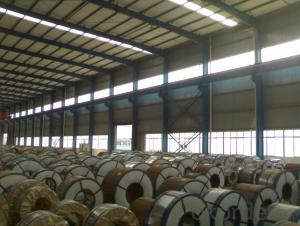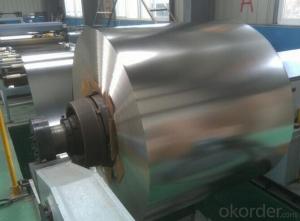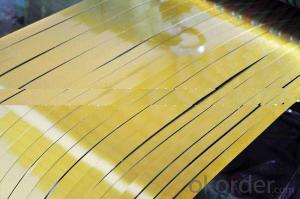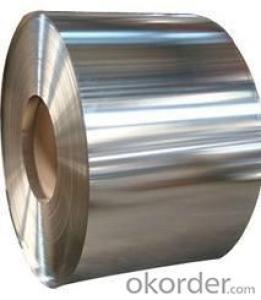Electrolytic Tinplate for Food and Chemical Packaging
- Loading Port:
- Tianjin
- Payment Terms:
- TT OR LC
- Min Order Qty:
- 25 m.t
- Supply Capability:
- 7000 m.t/month
OKorder Service Pledge
OKorder Financial Service
You Might Also Like
1.Structure of Electrolytic Tinplate for Food and Chemical Packaging Description
Electrolytic Tin Plate Coils and Sheets for Foods Metal Packaging, is one thin steel sheet with a coating of tin applied by electrolytic deposition. Tinplate made by this process is essentially a sandwich in which the central core is strip steel. This core is cleaned in a pickling solution and then fed through tanks containing electrolyte, where tin is deposited on both sides. As the strip passes between high-frequency electric induction coils, it is heated so that the tin coating melts and flows to form a lustrous coat.
2.Main Features of the Electrolytic Tinplate for Food and Chemical Packaging
Appearance – Electrolytic Tin Plate is characterized by its beautiful metallic luster. Products with various kinds of surface roughness are produced by selecting the surface finish of the substrate steel sheet.
Paintability and printability – Electrolytic Tin Plates have excellent paintability and printability. Printing is beautifully finished using various lacquers and inks.
Formability and strength – Electrolytic Tin Plates have got very good formability and strength. By selecting a proper temper grade, appropriate formability is obtained for different applications as well as the required strength after forming.
Corrosion resistance – Tinplate has got good corrosion resistance. By selecting a proper coating weight, appropriate corrosion resistance is obtained against container contents. Coated items should meet 24 hour 5 % salt spray requirement.
Solderability and weldability – Electrolytic Tin Plates can be joined both by soldering or welding. These properties of tinplate are used for making various types of cans.
Hygienic – Tin coating provides good and non toxic barrier properties to protect food products from impurities, bacteria, moisture, light and odours.
Safe – Tinplate being low weight and high strength makes food cans easy to ship and transport.
Eco friendly – Tinplate offers 100 % recyclability.
Tin is not good for low temperature applications since it changes structure and loses adhesion when exposed to temperatures below – 40 deg C.
3.Electrolytic Tinplate for Food and Chemical Packaging Images
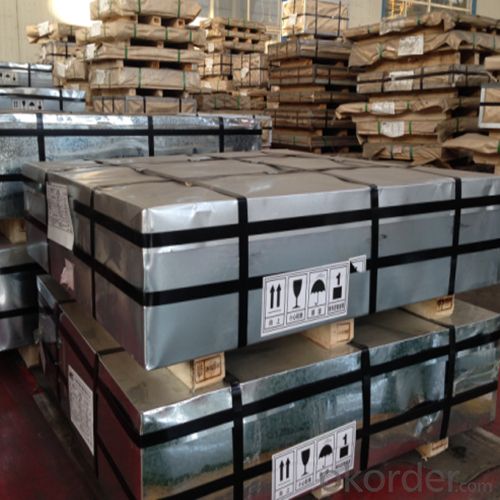
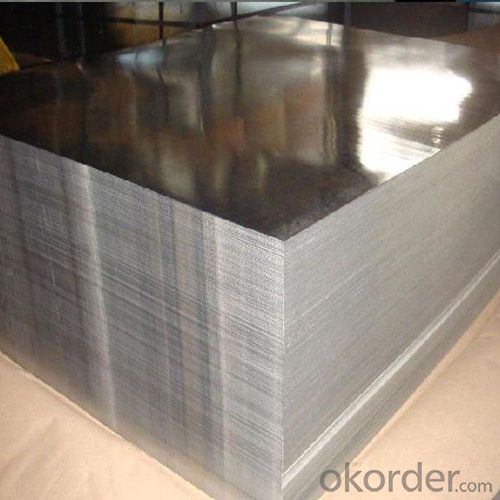
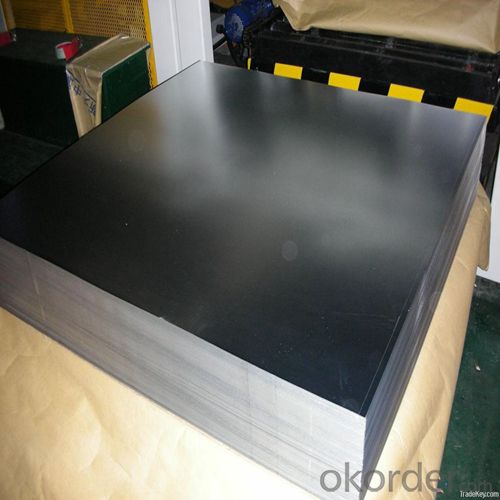
4.Electrolytic Tinplate for Food and Chemical Packaging Specification
Standard | ISO 11949 -1995, GB/T2520-2000,JIS G3303,ASTM A623, BS EN 10202
|
Material | MR,SPCC |
Thickness | 0.15mm - 0.50mm |
Width | 600mm -1150mm |
Temper | T1-T5 |
Annealing | BA & CA |
Coil Inner Diameter | 508mm |
Weight | 6-10 tons/coil 1~1.7 tons/sheets bundle |
Passivation | 311 |
Oil | DOS |
Surface | Finish,bright,stone,matte,silver |
5.FAQ of Electrolytic Tinplate for Food and Chemical Packaging
-What your tinplate material is used for ?
Tinplate is widely used for the packaging of products. Such as food cans,
beverage cans, pet cans, closures, general line cans and so on.
Printed Tinplate is offered!!
-How to place .an order or contact you ?
Please send us Email. we will give you a quick response in seconds .
- How is your quality ?
All our quality is prime even the secondary quality . We have many years experience
In this field with serious quality control standard . Advanced equipment, We welcome your visit to our factory .
- Q:How does tinplate contribute to sustainability efforts?
- Tinplate contributes to sustainability efforts in several ways. Firstly, it is a highly recyclable material, which means that it can be reused multiple times without losing its properties. This helps reduce the demand for new raw materials and minimizes waste generation. Additionally, tinplate is often used as packaging material for food and beverages, providing a protective and durable barrier that extends the shelf life of products, reducing food waste. Furthermore, tinplate cans are lightweight, making them more energy-efficient during transportation, thus reducing carbon emissions. Overall, tinplate's recyclability, protective properties, and energy efficiency make it a sustainable choice for various industries.
- Q:What are the different types of tinplate finishes available?
- There are primarily three types of tinplate finishes available: bright, stone, and matte. Bright tinplate has a shiny and reflective surface, stone tinplate has a textured and grainy appearance, and matte tinplate has a smooth and non-reflective finish. These different finishes offer various aesthetic options for packaging and can be chosen based on the desired look and feel of the final product.
- Q:Can tinplate be used for electrical applications?
- Yes, tinplate can be used for electrical applications. Tinplate is a thin steel sheet coated with a layer of tin, which provides corrosion resistance and electrical conductivity. This makes it suitable for manufacturing electrical components and devices such as cans, containers, and small appliances.
- Q:How does tinplate affect the overall product freshness?
- Tinplate packaging helps to preserve the overall product freshness by providing a protective barrier against moisture, light, and oxygen. This prevents the product from spoiling or deteriorating quickly, allowing it to maintain its quality and freshness for a longer period of time.
- Q:Can tinplate be used for art and sculptures?
- Yes, tinplate can be used for art and sculptures. Its malleability and durability make it a suitable material for creating various artistic forms and sculptures.
- Q:How is tinplate recycled?
- Tinplate is recycled through a process known as steel scrap recycling. First, the tinplate is collected and sorted. Then, it undergoes a shredding and melting process to separate the steel from other materials. The melted steel is purified and refined, removing any impurities. Finally, the purified steel is used to produce new tinplate products, completing the recycling cycle.
- Q:How does tinplate contribute to the conductivity of electrical components?
- Tinplate contributes to the conductivity of electrical components by providing a thin layer of tin coating on the surface of the component. This tin coating enhances the conductivity of the underlying material, such as copper or steel, by reducing the contact resistance and preventing oxidation. Tin is a highly conductive metal and acts as a barrier against corrosion, ensuring the longevity and reliability of electrical components.
- Q:How does tinplate perform in terms of UV resistance?
- Tinplate generally has poor UV resistance, meaning it is not highly resistant to the damaging effects of ultraviolet radiation.
- Q:What are the common opening mechanisms for tinplate containers?
- The common opening mechanisms for tinplate containers include pull-tab lids, twist-off caps, and lever lids.
- Q:What are the main technological advancements in tinplate production?
- The main technological advancements in tinplate production include the development of automated and high-speed production lines, the introduction of advanced coating techniques to enhance corrosion resistance, the implementation of precise control systems to ensure consistent quality, and the use of innovative materials and alloys to improve tinplate strength and durability. Additionally, advancements in recycling and sustainability practices have been made to reduce environmental impact in tinplate production.
1. Manufacturer Overview |
|
|---|---|
| Location | |
| Year Established | |
| Annual Output Value | |
| Main Markets | |
| Company Certifications | |
2. Manufacturer Certificates |
|
|---|---|
| a) Certification Name | |
| Range | |
| Reference | |
| Validity Period | |
3. Manufacturer Capability |
|
|---|---|
| a)Trade Capacity | |
| Nearest Port | |
| Export Percentage | |
| No.of Employees in Trade Department | |
| Language Spoken: | |
| b)Factory Information | |
| Factory Size: | |
| No. of Production Lines | |
| Contract Manufacturing | |
| Product Price Range | |
Send your message to us
Electrolytic Tinplate for Food and Chemical Packaging
- Loading Port:
- Tianjin
- Payment Terms:
- TT OR LC
- Min Order Qty:
- 25 m.t
- Supply Capability:
- 7000 m.t/month
OKorder Service Pledge
OKorder Financial Service
Similar products
New products
Hot products
Hot Searches
Related keywords



